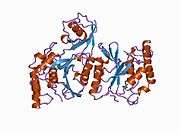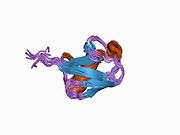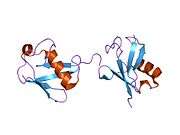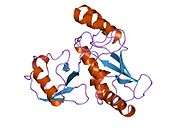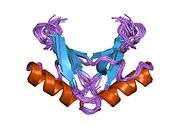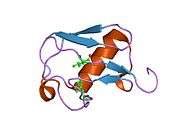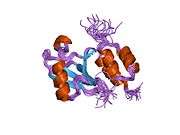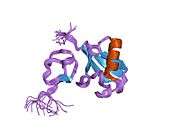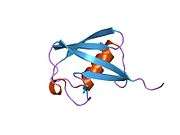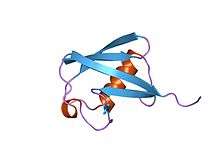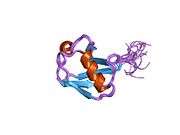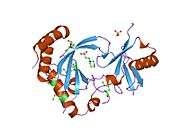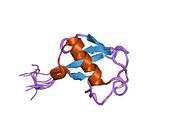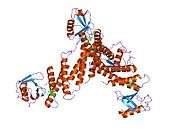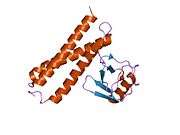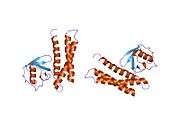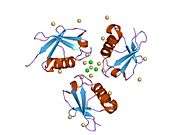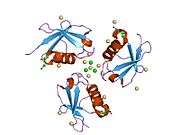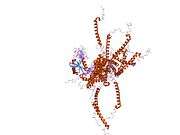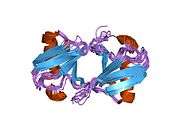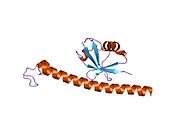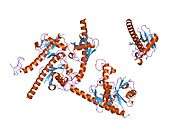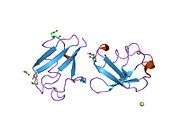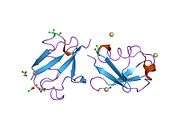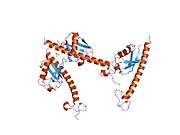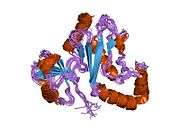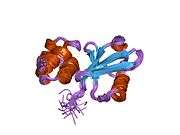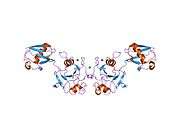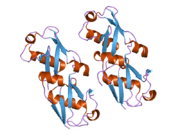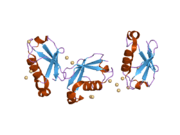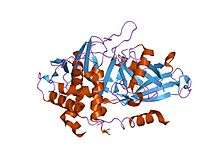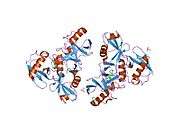RPS27A
| RPS27A
|
|---|
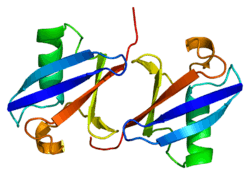 |
| Available structures |
|---|
| PDB | Ortholog search: PDBe RCSB |
|---|
| List of PDB id codes |
|
2KTF, 2L0F, 2L0T, 2XK5, 3AXC, 3NHE, 3NOB, 3PHW, 3TBL, 4UG0, 4V6X, 5AJ0, 4R62, 5FLX, 4UJD, 4KZZ, 4UJC, 3J7P, 4KZY, 4D5L, 3J7R, 4D61, 4KZX, 4UJE, 5A2Q
| | |
| Identifiers |
|---|
| Aliases |
RPS27A, CEP80, HEL112, S27A, UBA80, UBC, UBCEP1, UBCEP80, ribosomal protein S27a |
|---|
| External IDs |
MGI: 1925544 HomoloGene: 37715 GeneCards: RPS27A
|
|---|
| Gene ontology |
|---|
| Molecular function |
• metal ion binding
• structural constituent of ribosome
• protein binding
• poly(A) RNA binding
|
|---|
| Cellular component |
• cytoplasm
• endocytic vesicle membrane
• cytosol
• membrane
• nucleus
• ribosome
• myelin sheath
• extracellular fluid
• cytosolic small ribosomal subunit
• nucleolus
• extracellular exosome
• plasma membrane
• nucleoplasm
• small ribosomal subunit
• endosome membrane
• intracellular ribonucleoprotein complex
|
|---|
| Biological process |
• DNA damage response, signal transduction by p53 class mediator resulting in cell cycle arrest
• negative regulation of epidermal growth factor receptor signaling pathway
• interstrand cross-link repair
• nucleotide-excision repair, DNA damage recognition
• positive regulation of canonical Wnt signaling pathway
• tumor necrosis factor-mediated signaling pathway
• regulation of necrotic cell death
• regulation of type I interferon production
• TRIF-dependent toll-like receptor signaling pathway
• Fc-epsilon receptor signaling pathway
• endosomal transport
• global genome nucleotide-excision repair
• NIK/NF-kappaB signaling
• G2/M transition of mitotic cell cycle
• stress-activated MAPK cascade
• negative regulation of ubiquitin-protein ligase activity involved in mitotic cell cycle
• transforming growth factor beta receptor signaling pathway
• macroautophagy
• negative regulation of canonical Wnt signaling pathway
• DNA damage response, detection of DNA damage
• nucleotide-excision repair, DNA gap filling
• viral transcription
• error-free translesion synthesis
• regulation of tumor necrosis factor-mediated signaling pathway
• stimulatory C-type lectin receptor signaling pathway
• negative regulation of transforming growth factor beta receptor signaling pathway
• SRP-dependent cotranslational protein targeting to membrane
• JNK cascade
• regulation of transcription from RNA polymerase II promoter in response to hypoxia
• nucleotide-excision repair, DNA incision
• I-kappaB kinase/NF-kappaB signaling
• innate immune response
• positive regulation of ubiquitin-protein ligase activity involved in regulation of mitotic cell cycle transition
• Notch signaling pathway
• regulation of mRNA stability
• protein polyubiquitination
• negative regulation of apoptotic process
• negative regulation of transcription from RNA polymerase II promoter
• virion assembly
• activation of MAPK activity
• positive regulation of NF-kappaB transcription factor activity
• anaphase-promoting complex-dependent catabolic process
• negative regulation of type I interferon production
• nuclear-transcribed mRNA catabolic process, nonsense-mediated decay
• nucleotide-binding oligomerization domain containing signaling pathway
• cellular protein metabolic process
• intracellular transport of virus
• viral life cycle
• MyD88-dependent toll-like receptor signaling pathway
• error-prone translesion synthesis
• MAPK cascade
• fibroblast growth factor receptor signaling pathway
• ion transmembrane transport
• glycogen biosynthetic process
• positive regulation of apoptotic process
• translational initiation
• positive regulation of I-kappaB kinase/NF-kappaB signaling
• translesion synthesis
• transcription-coupled nucleotide-excision repair
• T cell receptor signaling pathway
• MyD88-independent toll-like receptor signaling pathway
• positive regulation of transcription from RNA polymerase II promoter
• regulation of signal transduction by p53 class mediator
• positive regulation of epidermal growth factor receptor signaling pathway
• Wnt signaling pathway
• nucleotide-excision repair, DNA duplex unwinding
• nucleotide-excision repair, DNA incision, 5'-to lesion
• translation
• rRNA processing
• ERBB2 signaling pathway
• Wnt signaling pathway, planar cell polarity pathway
• protein ubiquitination involved in ubiquitin-dependent protein catabolic process
• nucleotide-excision repair, preincision complex assembly
• proteasome-mediated ubiquitin-dependent protein catabolic process
|
|---|
| Sources:Amigo / QuickGO | |
| Orthologs |
|---|
| Species |
Human |
Mouse |
|---|
| Entrez |
|
|
|---|
| Ensembl |
|
|
|---|
| UniProt |
|
|
|---|
| RefSeq (mRNA) |
| |
|---|
| RefSeq (protein) |
| |
|---|
| Location (UCSC) |
Chr 2: 55.23 – 55.24 Mb |
Chr 11: 29.55 – 29.55 Mb |
|---|
| PubMed search |
[1] |
[2]
|
|---|
| Wikidata |
40S ribosomal protein S27a is a protein that in humans is encoded by the RPS27A gene.[3][4]
Ubiquitin, a highly conserved protein that has a major role in targeting cellular proteins for degradation by the 26S proteosome, is synthesized as a precursor protein consisting of either polyubiquitin chains or a single ubiquitin fused to an unrelated protein. This gene encodes a fusion protein consisting of ubiquitin at the N terminus and ribosomal protein S27a at the C terminus. When expressed in yeast, the protein is post-translationally processed, generating free ubiquitin monomer and ribosomal protein S27a. Ribosomal protein S27a is a component of the 40S subunit of the ribosome and belongs to the S27AE family of ribosomal proteins. It contains C4-type zinc finger domains and is located in the cytoplasm. Pseudogenes derived from this gene are present in the genome. As with ribosomal protein S27a, ribosomal protein L40 is also synthesized as a fusion protein with ubiquitin; similarly, ribosomal protein S30 is synthesized as a fusion protein with the ubiquitin-like protein fubi.[4]
References
Further reading
- Wool IG, Chan YL, Glück A (1996). "Structure and evolution of mammalian ribosomal proteins.". Biochem. Cell Biol. 73 (11–12): 933–47. doi:10.1139/o95-101. PMID 8722009.
- Adams SM, Sharp MG, Walker RA, et al. (1992). "Differential expression of translation-associated genes in benign and malignant human breast tumours". Br. J. Cancer. 65 (1): 65–71. doi:10.1038/bjc.1992.12. PMC 1977345
 . PMID 1370760.
. PMID 1370760.
- Pancré V, Pierce RJ, Fournier F, et al. (1991). "Effect of ubiquitin on platelet functions: possible identity with platelet activity suppressive lymphokine (PASL)". Eur. J. Immunol. 21 (11): 2735–41. doi:10.1002/eji.1830211113. PMID 1657614.
- Kanayama H, Tanaka K, Aki M, et al. (1992). "Changes in expressions of proteasome and ubiquitin genes in human renal cancer cells". Cancer Res. 51 (24): 6677–85. PMID 1660345.
- Monia BP, Ecker DJ, Jonnalagadda S, et al. (1989). "Gene synthesis, expression, and processing of human ubiquitin carboxyl extension proteins". J. Biol. Chem. 264 (7): 4093–103. PMID 2537304.
- Redman KL, Rechsteiner M (1989). "Identification of the long ubiquitin extension as ribosomal protein S27a". Nature. 338 (6214): 438–40. doi:10.1038/338438a0. PMID 2538756.
- Lund PK, Moats-Staats BM, Simmons JG, et al. (1985). "Nucleotide sequence analysis of a cDNA encoding human ubiquitin reveals that ubiquitin is synthesized as a precursor". J. Biol. Chem. 260 (12): 7609–13. PMID 2581967.
- Maruyama K, Sugano S (1994). "Oligo-capping: a simple method to replace the cap structure of eukaryotic mRNAs with oligoribonucleotides". Gene. 138 (1–2): 171–4. doi:10.1016/0378-1119(94)90802-8. PMID 8125298.
- Vladimirov SN, Ivanov AV, Karpova GG, et al. (1996). "Characterization of the human small-ribosomal-subunit proteins by N-terminal and internal sequencing, and mass spectrometry". Eur. J. Biochem. 239 (1): 144–9. doi:10.1111/j.1432-1033.1996.0144u.x. PMID 8706699.
- Suzuki Y, Yoshitomo-Nakagawa K, Maruyama K, et al. (1997). "Construction and characterization of a full length-enriched and a 5'-end-enriched cDNA library". Gene. 200 (1–2): 149–56. doi:10.1016/S0378-1119(97)00411-3. PMID 9373149.
- Kirschner LS, Stratakis CA (2000). "Structure of the human ubiquitin fusion gene Uba80 (RPS27a) and one of its pseudogenes". Biochem. Biophys. Res. Commun. 270 (3): 1106–10. doi:10.1006/bbrc.2000.2568. PMID 10772958.
- Petersen BO, Wagener C, Marinoni F, et al. (2000). "Cell cycle– and cell growth–regulated proteolysis of mammalian CDC6 is dependent on APC–CDH1". Genes Dev. 14 (18): 2330–43. doi:10.1101/gad.832500. PMC 316932
 . PMID 10995389.
. PMID 10995389.
- Bolton D, Evans PA, Stott K, Broadhurst RW (2002). "Structure and properties of a dimeric N-terminal fragment of human ubiquitin". J. Mol. Biol. 314 (4): 773–87. doi:10.1006/jmbi.2001.5181. PMID 11733996.
- Yoshihama M, Uechi T, Asakawa S, et al. (2002). "The Human Ribosomal Protein Genes: Sequencing and Comparative Analysis of 73 Genes". Genome Res. 12 (3): 379–90. doi:10.1101/gr.214202. PMC 155282
 . PMID 11875025.
. PMID 11875025.
- Strausberg RL, Feingold EA, Grouse LH, et al. (2003). "Generation and initial analysis of more than 15,000 full-length human and mouse cDNA sequences". Proc. Natl. Acad. Sci. U.S.A. 99 (26): 16899–903. doi:10.1073/pnas.242603899. PMC 139241
 . PMID 12477932.
. PMID 12477932.
- Cohen BD, Bariteau JT, Magenis LM, Dias JA (2003). "Regulation of follitropin receptor cell surface residency by the ubiquitin-proteasome pathway". Endocrinology. 144 (10): 4393–402. doi:10.1210/en.2002-0063. PMID 12960054.
- Ota T, Suzuki Y, Nishikawa T, et al. (2004). "Complete sequencing and characterization of 21,243 full-length human cDNAs". Nat. Genet. 36 (1): 40–5. doi:10.1038/ng1285. PMID 14702039.
- Li H, Seth A (2004). "An RNF11: Smurf2 complex mediates ubiquitination of the AMSH protein". Oncogene. 23 (10): 1801–8. doi:10.1038/sj.onc.1207319. PMID 14755250.
PDB gallery |
|---|
|
| 1aar: STRUCTURE OF A DIUBIQUITIN CONJUGATE AND A MODEL FOR INTERACTION WITH UBIQUITIN CONJUGATING ENZYME (E2) |
| 1cmx: STRUCTURAL BASIS FOR THE SPECIFICITY OF UBIQUITIN C-TERMINAL HYDROLASES |
| 1d3z: UBIQUITIN NMR STRUCTURE |
| 1f9j: STRUCTURE OF A NEW CRYSTAL FORM OF TETRAUBIQUITIN |
| 1fxt: STRUCTURE OF A CONJUGATING ENZYME-UBIQUITIN THIOLESTER COMPLEX |
| 1g6j: STRUCTURE OF RECOMBINANT HUMAN UBIQUITIN IN AOT REVERSE MICELLES |
| 1gjz: SOLUTION STRUCTURE OF A DIMERIC N-TERMINAL FRAGMENT OF HUMAN UBIQUITIN |
| 1nbf: Crystal structure of a UBP-family deubiquitinating enzyme in isolation and in complex with ubiquitin aldehyde |
| 1ogw: SYNTHETIC UBIQUITIN WITH FLUORO-LEU AT 50 AND 67 |
| 1otr: Solution Structure of a CUE-Ubiquitin Complex |
| 1p3q: Mechanism of Ubiquitin Recognition by the CUE Domain of VPS9 |
| 1q0w: Solution structure of Vps27 amino-terminal UIM-ubiquitin complex |
| 1q5w: Ubiquitin Recognition by Npl4 Zinc-Fingers |
| 1s1q: TSG101(UEV) domain in complex with Ubiquitin |
| 1sif: Crystal structure of a multiple hydrophobic core mutant of ubiquitin |
| 1tbe: STRUCTURE OF TETRAUBIQUITIN SHOWS HOW MULTIUBIQUITIN CHAINS CAN BE FORMED |
| 1ubi: SYNTHETIC STRUCTURAL AND BIOLOGICAL STUDIES OF THE UBIQUITIN SYSTEM. PART 1 |
| 1ubq: STRUCTURE OF UBIQUITIN REFINED AT 1.8 ANGSTROMS RESOLUTION |
| 1ud7: SOLUTION STRUCTURE OF THE DESIGNED HYDROPHOBIC CORE MUTANT OF UBIQUITIN, 1D7 |
| 1uzx: A COMPLEX OF THE VPS23 UEV WITH UBIQUITIN |
| 1v80: Solution structures of ubiquitin at 30 bar and 3 kbar |
| 1v81: Solution structures of ubiquitin at 30 bar and 3 kbar |
| 1wr1: The complex structure of Dsk2p UBA with ubiquitin |
| 1wr6: Crystal structure of GGA3 GAT domain in complex with ubiquitin |
| 1wrd: Crystal structure of Tom1 GAT domain in complex with ubiquitin |
| 1xd3: Crystal structure of UCHL3-UbVME complex |
| 1xqq: Simultaneous determination of protein structure and dynamics |
| 1yd8: COMPLEX OF HUMAN GGA3 GAT DOMAIN AND UBIQUITIN |
| 1yiw: X-ray Crystal Structure of a Chemically Synthesized Ubiquitin |
| 1yj1: X-ray Crystal Structure of a Chemically Synthesized [D-Gln35]Ubiquitin |
| 1yx5: Solution Structure of S5a UIM-1/Ubiquitin Complex |
| 1yx6: Solution Structure of S5a UIM-2/Ubiquitin Complex |
| 1zgu: Solution structure of the human Mms2-Ubiquitin complex |
| 2ayo: Structure of USP14 bound to ubquitin aldehyde |
| 2bgf: NMR STRUCTURE OF LYS48-LINKED DI-UBIQUITIN USING CHEMICAL SHIFT PERTURBATION DATA TOGETHER WITH RDCS AND 15N-RELAXATION DATA |
| 2c7m: HUMAN RABEX-5 RESIDUES 1-74 IN COMPLEX WITH UBIQUITIN |
| 2c7n: HUMAN RABEX-5 RESIDUES 1-74 IN COMPLEX WITH UBIQUITIN |
| 2d3g: Double sided ubiquitin binding of Hrs-UIM |
| 2den: Solution Structure of the Ubiquitin-Associated Domain of Human BMSC-UbP and its Complex with Ubiquitin |
| 2dx5: The complex structure between the mouse EAP45-GLUE domain and ubiquitin |
| 2fcm: X-ray Crystal Structure of a Chemically Synthesized [D-Gln35]Ubiquitin with a Cubic Space Group |
| 2fcn: X-ray Crystal Structure of a Chemically Synthesized [D-Val35]Ubiquitin with a Cubic Space Group |
| 2fcq: X-ray Crystal Structure of a Chemically Synthesized Ubiquitin with a Cubic Space Group |
| 2fcs: X-ray Crystal Structure of a Chemically Synthesized [L-Gln35]Ubiquitin with a Cubic Space Group |
| 2fid: Crystal Structure of a Bovine Rabex-5 fragment complexed with ubiquitin |
| 2fif: Crystal Structure of a Bovine Rabex-5 fragment complexed with ubiquitin |
| 2fuh: Solution Structure of the UbcH5c/Ub Non-covalent Complex |
| 2g3q: Solution Structure of Ede1 UBA-ubiquitin complex |
| 2g45: Co-crystal structure of znf ubp domain from the deubiquitinating enzyme isopeptidase T (isot) in complex with ubiquitin |
| 2gbj: Crystal Structure of the 9-10 8 Glycine Insertion Mutant of Ubiquitin. |
| 2gbk: Crystal Structure of the 9-10 MoaD Insertion Mutant of Ubiquitin |
| 2gbm: Crystal Structure of the 35-36 8 Glycine Insertion Mutant of Ubiquitin |
| 2gbn: Crystal Structure of the 35-36 8 Glycine Insertion Mutant of Ubiquitin |
| 2gbr: Crystal Structure of the 35-36 MoaD Insertion Mutant of Ubiquitin |
| 2gmi: Mms2/Ubc13~Ubiquitin |
| 2hd5: USP2 in complex with ubiquitin |
| 2hth: Structural basis for ubiquitin recognition by the human EAP45/ESCRT-II GLUE domain |
| 2ibi: Covalent Ubiquitin-USP2 Complex |
| 2j7q: CRYSTAL STRUCTURE OF THE UBIQUITIN-SPECIFIC PROTEASE ENCODED BY MURINE CYTOMEGALOVIRUS TEGUMENT PROTEIN M48 IN COMPLEX WITH A UBQUITIN-BASED SUICIDE SUBSTRATE |
| 2nr2: The MUMO (minimal under-restraining minimal over-restraining) method for the determination of native states ensembles of proteins |
| 2o6v: Crystal structure and solution NMR studies of Lys48-linked tetraubiquitin at neutral pH |
| 2oob: crystal structure of the UBA domain from Cbl-b ubiquitin ligase in complex with ubiquitin |
|
|
 . PMID 1370760.
. PMID 1370760. . PMID 10995389.
. PMID 10995389. . PMID 11875025.
. PMID 11875025. . PMID 12477932.
. PMID 12477932.

